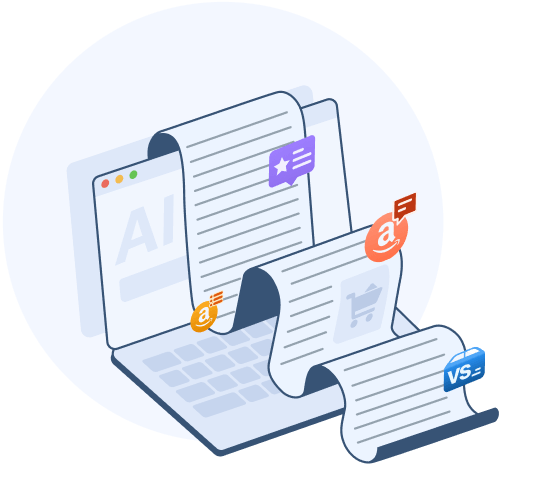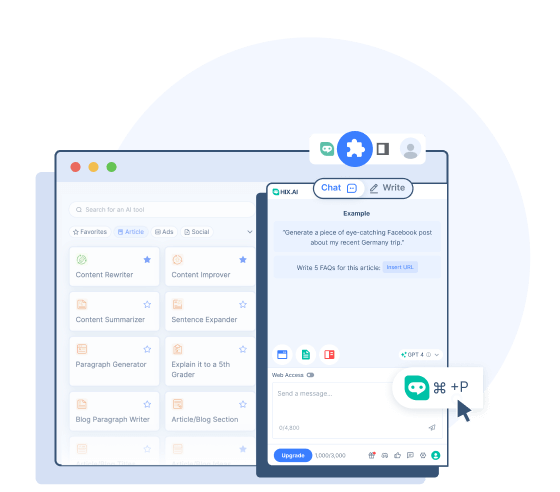Email writing in English can be a little confusing if it's not your first language. It can be challenging for English language speakers, too! Why? Because the English email format has some set rules, conventions, and structures that you simply must learn.
Is it hard to write emails in English? No, it's not. As long as you stick to the rules we're going to lay down in this guide, you'll have no problems producing professional emails for any situation or circumstance.
Ready to learn? We're going to cover the 4-part English language email format and then bring it to life with 5 samples, covering:
- Professional email to boss
- Professional email to a client/customer
- Professional complaint email
- Professional invoice email
- Professional connection request email
English language emails are covered by some etiquette that's essential to know. The HIX.AI team of email insiders has produced a guide to help you to achieve email excellence!
Streamline Your Email Writing with AI
Before exploring our detailed samples, enhance your email writing efficiency by trying our free AI email generator, which can craft personalized emails instantly.
Do I have to use the English email format?
Emails are funny things. They're definitely a 21st-century technology, but they're still governed by the conventions of the Victorian age. Yes, the time of horse-drawn transport, handwritten letters, and excessive formality.
Some people find the English language format can be, well, formal – and it is. That doesn't mean it constrains creativity or innovation. It just provides some boundaries.
The professional email format is accepted and understood across the world. So, when you're emailing people in other businesses, or other countries, it's vital that you stick to the format. This will ensure your emails are understood by everyone who receives them.
Should you always use the English-language format? Yes, if you're writing professional emails – but there are some exceptions.
Cold emails and sales emails can – and often do – use a different format. The purpose of this is to shock the reader who is expecting a standard structure.
Also, if you're emailing friends (or sending any personal emails), you can structure them however you wish.
All this talk of the English language format has probably got you wondering what it is... So let's get to that now.
HIX Email WriterWrite/Reply to Emails Instantly
Type // to draft emails in no time
Get tailored replies with one click
Quickly summarize a received email
The English language email format explained
We can track the structure of emails all the way back to the 19th century (and even before that).
Of course, things have changed a little bit – with things like the subject line not being a requirement in 1872. But we're still basically using the same format.
So what is it?
The English language email format has 4 parts to it. You'll need to understand what each section is and its purpose to produce professional emails.
The 4 steps are:
- Email subject line
- Email greeting
- Email body copy
- Email sign-off/next steps
We're going to work through time one by one to explain the correct format. Once you've internalized this, you can use this format for any email you want to write.
Email subject line
Every great English email starts with the subject line. Your subject line is a snapshot inside your email. It needs to be encouraging enough to get them to open the email.
The best subject lines are:
- Short – between 5 - 7 words (ideally, but it can be longer if essential)
- Simple and serious
- Provide a clear description of what the email is about
- Includes dates, references, and titles (where appropriate)
- Includes a deadline (if there is one)
- Provide an instruction ("Urgent", or "Please respond") if you want to
We recommend subject lines are short and clear because we receive hundreds of emails a day, which means subject lines that are unclear or confusing could be at risk of being ignored.
Short subject lines are also easier to read on mobile devices.
Lesson #1 – Keep subject lines short, simple to understand, and clear.
Email greeting
Your email greeting is your intro to the email. This is where we deviate (a little) from the Victorian age. About 20 years ago, email writers would start emails like:
- Dear Sir/Madam
- Dear Mr (name)
- Dear Ms. (name)
But today, we don't. Why? Because email writing in English constantly changes, these are outdated, irrelevant, and for some people, offensive. Instead, even the most formal emails are introduced this way:
- Hi (person's first name)
- Hello (person's first name)
- Dear (person's first name)
Lesson #2 You should always use the person's first name. This helps to break down barriers and establish a personal connection immediately.
Learn more about how to start an email effectively.
Email body copy
The body copy is where you build your message up. It could be as short as a single sentence or run to pages and pages of details. There are no rules about email length (although etiquette dictates it should be as short as possible).
Typically, the email format works like this:
- Welcome & intro – you don't dive into business, but provide a positive welcome and (if you don't know the person) introduce yourself. This can include who you are and where you work.
- State the purpose of your email – Get to the point quickly and state why you're messaging. "I'm applying for the advertised role of (position)" is perfect.
- Go into detail – If you need to add extra information, here is your chance. Emails aren't essays, so keep things as short as possible. Use things like bullet points to break up text and convey complex information as simply as possible.
The body copy should be brief. You can always add links to other sources or attachments to help the reader understand what your message is about.
Lesson #3 – Include all information but be brief. Professional emails quickly get to the point.
Email sign-off/next steps
Professional emails should have a purpose (f not, why are you sending it?). This could be providing emails, asking for confirmation an application has been received, or asking someone to act.
In email terms, it's known as a call-to-action (CTA). CTAs are instructions to do something and should always be at the end of your emails.
You must also check and ensure you've provided contact details and ways for people to contact you.
Your sign-off must be suitable for the situation. Some appropriate professional sign-offs include:
- Thanks
- Many thanks
- Best regards
- Kind regards
- Look forward to hearing from you
Avoid using overly fussy and formal endings such as:
- Yours sincerely
- Yours faithfully
Lesson #4 – Always include a CTA and explain the purpose of your professional email and the outcome you want.
Learn more closing lines for an English email.
5 professional emails in English
Do you understand the professional email format yet? If it's all still a mystery, here are 5 samples to show you how it's done.
These samples are engineered around some of the common types of professional emails you might need to send. Read them, learn from them, and understand the format before writing your own!
Professional English emails to boss
Your boss, manager, director, or CEO is going to expect you to understand and use the formal email format. In this professional email to boss sample, we engage someone in authority with a clear message that ticks all the right boxes.
Dear [Boss's Name],
I trust this email finds you well.
I am writing to discuss [Topic or Purpose of the Email]. [Include necessary and relevant details about the topic. Be concise and direct]
I believe your insights and guidance would be valuable in this matter. If necessary, we can schedule a meeting at a convenient time for you to further discuss this issue.
Thank you in advance for your time and consideration.
Best Regards,
[Your Name]
Read also: How to Reply an Email from Boss? (12 templates)
Professional English emails to a client/customer
Unless your customer is a personal friend, always stick to the email format. In this sample, we provide a simple and easy-to-follow message that's all about getting a response from your client/customer. You can use this for any day-to-day customer correspondence.
Dear [Recipient's Name],
I hope this message finds you well.
I am reaching out regarding [reference to the matter at hand]. [Provide the necessary details or queries related to the matter].
I look forward to your feedback or any questions you might have concerning this matter.
Thank you for your attention and cooperation.
Best Regards,
[Your Name]
Professional English complaint email
Upset at a product, service, or something else? Then don't stand for it; complain! This professional complaint email goes deep into the details and outlines your grievance, and pushes for a reply and a resolution.
Dear [Recipient's Name],
I am writing to express my disappointment and frustration with the recent service I received from your company.
On [date], I purchased [product/service] from your store/website. However, upon receiving the product/service, I discovered several issues and flaws that were not mentioned or visible at the time of purchase. These issues include [specific details of the problems].
I believe that as a loyal customer, I deserved a better experience and a product/service that meets the expected standards. Therefore, I kindly request a prompt resolution to this matter.
I look forward to your immediate response and a satisfactory solution to this issue.
Thank you for your attention.
Best regards,
[Your Name]
Read also: How to write an email to a professor (5 samples & templates)
Professional English invoice email
You could say, "I want to get paid!" but it won't get results. Instead, this professional invoice email is suitably short and effective and will ensure you get paid the full amount on the due date.
Dear [Recipient's Name],
I hope this email finds you well. I am writing to provide you with the invoice for [Project/Service name] as agreed. The total amount due is [Total amount].
Please find the attached invoice and kindly process the payment on or before the due date, which is [Due date].
If you have any questions or require any further details, please don't hesitate to reach out.
Thank you for your attention.
Best regards,
[Your Name]
Professional English connection request email
It's not what you know but who you know – so build your business network with the professional connection request. This type of Engilsh email can connect you with industry influences, colleagues, stakeholders, and recruiters.
Dear [Recipient's Name],
I hope this email finds you well. I am writing to request a professional connection with you.
I have been following your work in the industry for some time now and I am impressed with your expertise and accomplishments. I believe that connecting with you would be mutually beneficial, as we could potentially collaborate on projects or provide support to each other in our professional endeavors.
If you are open to connecting, I would appreciate the opportunity to learn more about your work and explore potential synergies. Please let me know if you would be open to connecting on [platform of choice, e.g., LinkedIn] or any other platform that is convenient for you.
Thank you for your attention and consideration.
Best regards,
[Your Name]
English-language email etiquette – 10 tips
The English language can be complicated, confusing, and challenging to master – especially when writing English emails. Here are 10 etiquette tips to follow when writing an email in English:
- Keep subject lines to 5 or 7 words (or risk being ignored or unread!)
- Use a greeting suitable for 2023 (Hi), not 1823 (Dear Sir/Madam). Learn what are some common opening sentences for an English email.
- Start every email with a (virtual) smile, express gratitude and introduce yourself.
- Set out the purpose of your email in one or two sentences.
- Each paragraph should have a single purpose or thought.
- Keep paragraphs short for mobile readers!
- Always include a CTA.
- Never forget your contact details.
- Choose a suitable sign-off.
- Proofread before sending or risk embarrassing yourself.
Conclusion
The ability to write emails in English is one of the most important skills you'll learn, so spend time reading through this and internalizing the concepts. We can bore you with the reasons, but the reality is if you write bad emails, you won't do well in business. Sorry that's harsh, but it's true. If you're concerned about the format or lacking confidence, then try HIX.AI email writer for better, faster, and more effective English emails.



